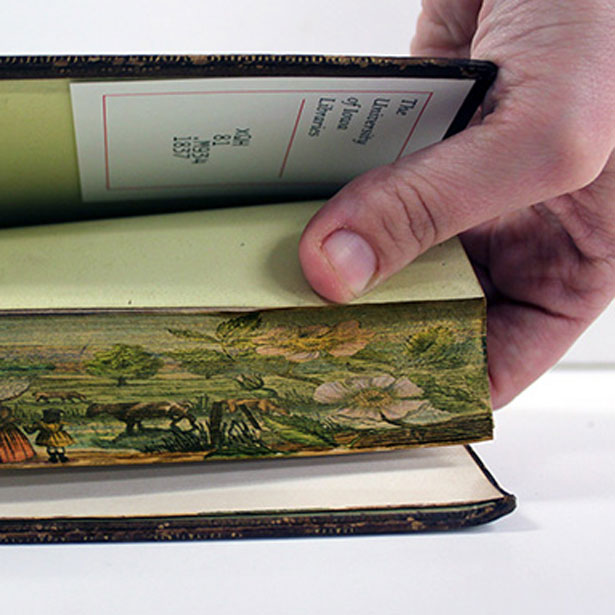A fore-edge painting is a technique of painting on the edges of the pages of a book. The artwork can only be seen when the pages are fanned, as seen in the animation below. When the book is closed, you don’t see the image because it is hidden by the gilding (i.e., the gold leaf applied to the edges of the page).
According to Encyclopedia Britannica, fore-edge paintings first arose during the European Middle Ages but came to prominence during the mid-17th century to the late 19th century. Anne C. Bromer for the Boston Public Library writes, “Most fore-edge painters working for binding firms did not sign their work, which explains why it is difficult to pinpoint and date the hidden paintings.”
Thanks to the generous gifts from Anne and David Bromer and Albert H. Wiggin, the Boston Public Library holds one of the finest collections of fore-edge paintings in the United States. Most of the collection has been put online for the world to enjoy and features more than 200 high-resolution images; complete with additional videos, articles and information.
The University of Iowa and Colossal recently featured a few fore-edge paintings with animated gifs that can also be seen below.
1. The causes, appearances, and effects of the
seasonal decay and decomposition of nature, 1837 by Robert Mudie
2. The Holy Bible
Split fore-edge painting
3. Letters of Lady Rachel Russell, 1801
by J. Mawman
4. Analysis of the Game of Chess, 1790
by François-André Danican Philidor
5. Characteristics of women, moral, political, and historical, v.2 1833
by Anna Jameson
Painting of Anne Hathaway’s Cottage
6. Speeches of Henry Lord Brougham, v.1 1838
by Henry Lord Brougham
A view of Philadelphia showing the Delaware
7. Jeanne d’Arc
Author Unknown
The People Of Orleans Greet Joan Of Arc
8. The rod and the gun, 1841
by James Wilson
9. Poems by the late William Cowper, Esq., v.2 1820
by William Cowper
10. The speeches of the right honorable William Pitt, v.2 1808
by William Pitt
George Washington and Benjamin Franklin
11. The causes, appearances, and effects of the
seasonal decay and decomposition of nature, 1837 by Robert Mudie
12. The poetical works of Thomas Moore, 1865
by Thomas Moore
View Of Enniscorthy, England
13. The lord of the isles, 1815
by Walter Scott
Carrick Castle In Argyll, Scotland
14. The world before the flood, 1819
by James Montgomery
15. The rambler, v.1 1825
by Samuel Johnson
Old Wych Street, London
16. The complete angler of Isaak Walton and Charles Cotton, 1835
by Izaak Walton
17. The Education of Henry Adams, 1918
by Henry Adams
18. Jerusalem delivered (Torquato Tasso), v.1 1797
by John Hoole
19. Oberon, 1798
by William Sotheby
20. The Holy Bible, 1811
St Paul’s Cathedral
21. The lay of the last minstrel, 1823
by Sir Walter Bart Scott
View of Kelso, Scotland
22. Paradise Lost, 1876
by John Milton
Milton Triptych
23. Latin and Italian poems of Milton, 1808
by John Milton
The Inn at Edmonton
24. Marmion, 1811
by Sir Walter Scott
Lindesfarne Abbey
25. The Poetical Works of Alexander Pope, 1863
by Alexander Pope
26. Poems by William Cowper, Esq., v.1 1808
by William Cowper
27. Select British poets, v.3 1824
Various Authors
Wimborne Minster
28. Rokeby, 1813
by Walter Scott
View of Barnard Castle
29. The causes, appearances, and effects of the
seasonal decay and decomposition of nature, 1837 by Robert Mudie
30. The curse of Kehama, 1812
by Robert Southey
Indian River Scene with Hindu Temple
31. Lalla Rookh, 1818
by Thomas Moore
Tyburn Turnpike, London
32. The lives of Dr. John Donne, Sir Henry Wotton, [etc.] 1824
by Izaak Walton
33. Poems by the late William Cowper, Esq., v.1 1820
by William Cowper
A View of Olney
34. The red true story book
by Andrew Lang and H. J. Ford
The Capture Of Joan Of Arc
35. The causes, appearances, and effects of the
seasonal decay and decomposition of nature, 1837 by Robert Mudie
36. Poems by the late William Cowper, Esq., v.2 1820
by William Cowper
37. Poems on several occasions, 1813
by Lord Edward Thurlow
A View of Dublin
38. The Holy Bible, v.2 1803
‘The Last Supper’
39. The Holy Bible, v.2 1795
The Mount Of Olives From The Slopes Of Zion
40. The anthologies, an extensive collection
of all compositions subsequent to the Liang dynasty
If you enjoyed this post, the Sifter
highly recommends:
